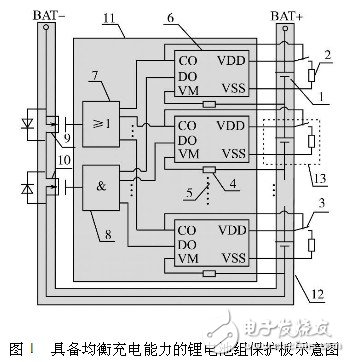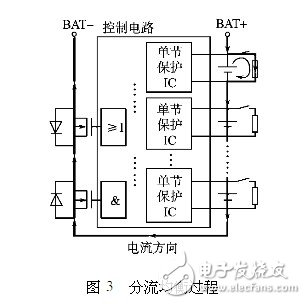1 Introduction
Commonly used equalization charging technologies include constant shunt resistor equalization charging, on-off shunt resistor equalization charging, average battery voltage equalization charging, switched capacitor equalization charging, buck converter equalization charging, and inductive equalization charging. When groups of lithium batteries are charged in series, each battery should be balanced and charged, otherwise the performance and life of the entire battery will be affected during use. The existing single-cell lithium battery protection chip does not include the balanced charging control function, and the multi-cell lithium battery protection chip equalization charging control function needs an external CPU; through serial communication with the protection chip (such as I2C bus), the The complexity and design difficulty of the protection circuit, the efficiency and reliability of the system are reduced, and the power consumption is increased.
In this paper, for the use of power lithium batteries in groups, each section of lithium batteries requires charging overvoltage, discharge undervoltage, overcurrent, short circuit protection, in the charging process to achieve the problem of equalization of the entire battery, a lithium-based battery is proposed. The design of the group balanced charging protection board. The solution adopts a single-cell lithium battery protection chip to protect the battery pack protection board with balanced charging function for protecting any group of lithium batteries in series. The simulation results and industrial production application prove that the protection board has perfect protection function, stable operation, high cost performance, and the balanced charging error is less than 50mV.
2 basic working principle of system design
A schematic diagram of a lithium battery pack protection board with balanced charging capability designed by a single-cell lithium battery protection chip is shown in FIG. 1 .

In Figure 1: 1 is a single-cell lithium-ion battery; 2 is a charging over-voltage shunt discharge branch resistor; 3 is a shunt discharge branch control switching device; 4 is an overcurrent detection protection resistor; 5 is an omitted lithium battery protection chip And circuit connection part; 6 is a single-cell lithium battery protection chip (generally including charging control pin CO, discharge control pin DO, discharge over current and short circuit detection pin VM, battery positive terminal VDD, battery negative terminal VSS, etc.); 7 is the charging over-voltage protection signal is isolated by the optocoupler to form a parallel relationship driving the gate of the charging control MOS tube in the main circuit; 8 is the discharge under-voltage, over-current, short-circuit protection signal is isolated by the optocoupler to form a series relationship driving main circuit The gate of the MOS transistor for medium discharge control; 9 is a charge control switching device; 10 is a discharge control switch device; 11 is a control circuit; 12 is a main circuit; 13 is a shunt discharge branch. The number of single-cell lithium battery protection chips is determined according to the number of lithium battery cells, and is used in series to protect the charge, discharge, overcurrent and short circuit conditions of the corresponding single-cell lithium battery. The system realizes balanced charging by controlling the on/off of the shunt discharge branch switching device while protecting the chip. This scheme is different from the traditional method of achieving balanced charging at the charger end, and reduces the design of the lithium battery pack charger. The cost of the application.
When the lithium battery pack is charged, the positive and negative poles of the external power supply are respectively connected to the positive and negative terminals of the battery pack, BAT+ and BAT-, and the charging current flows through the battery pack positive pole BAT+, the battery pack single-cell lithium battery 1~N, and the discharge control switch device. , charge control switch device, battery pack negative BAT-, current flow as shown in Figure 2.

In the control circuit part of the control circuit, the single-cell lithium battery protection chip's charging over-voltage protection control signal is isolated by optocoupler and then connected in parallel to provide the gate voltage for the conduction of the charging switch device in the main circuit; such as a certain section or several lithium batteries When the overvoltage protection state is first entered during the charging process, the overcurrent protection signal is controlled to discharge the shunt discharge branch connected in parallel between the positive and negative terminals of the single-cell lithium battery, and the corresponding single lithium battery connected in series in the charging circuit is broken. Leaving the charging circuit.
When the lithium battery pack is charged in series, the influence of the difference in the capacity of the single battery is ignored, and the battery with a small internal resistance is first filled. At this time, the corresponding overvoltage protection signal controls the switching device of the shunt discharge branch to be closed, and a shunt resistor is connected in parallel across the primary battery. According to the PNGV equivalent circuit model of the battery, the shunt branch resistance is equivalent to the load of the first full-cell lithium battery, and the battery is discharged through it to maintain the battery terminal voltage within a very small range near the full state. Assume that the lithium battery in the first section is fully charged and enters the overvoltage protection state, and the current flow in the main circuit and the shunt discharge branch is as shown in FIG. When all the single-cell batteries are charged into the over-voltage protection state, the voltages of all single-cell lithium batteries are completely equal within the error range, and the protection protection signals of the protection chips of each section become low, and the charging control switching devices in the main circuit cannot be obtained. The gate bias is provided to turn off, and the main circuit is disconnected, that is, balanced charging is achieved, and the charging process is completed.

When the battery pack is discharged, the external load is respectively connected to the positive and negative terminals BAT+ and BAT- of the battery pack, and the discharge current flows through the battery pack negative BAT-, the charge control switch device, the discharge control switch device, and the single-cell lithium battery N in the battery pack. ~1 and battery pack positive BAT+, current flow as shown in Figure 4. In the control circuit part of the control circuit, the single-cell lithium battery protection chip's discharge undervoltage protection, overcurrent and short circuit protection control signals are isolated by optocoupler and then connected in series to provide the gate voltage for the conduction of the discharge switch device in the main circuit; once the battery pack In the discharge process, a single-cell lithium battery undervoltage or overcurrent and short circuit are encountered, and the corresponding single-cell lithium battery discharge protection control signal becomes low, and the gate bias voltage cannot be provided to the discharge control switching device in the main circuit. Turn it off and the main circuit is disconnected, that is, the discharge process is terminated.

Accessories for cameras are mainly for care, protection, special effects and functions.
Lens hood: used on the end of a lens to block the sun or other light source to prevent glare and lens flare (see also matte box).
Lens cap: covers and protects the lens during storage.
Lens adapter: sometimes called a step-ring, adapts the lens to other size filters.
Lens filters: allow artificial colors or change light density.
Lens extension tubes allow close focus in macro photography.
Flash equipment: including light diffuser, mount and stand, reflector, soft box, trigger and cord.
Care and protection: including camera case and cover, maintenance tools, and screen protector.
Large format cameras use special equipment which includes magnifier loupe, view finder, angle finder, focusing rail /truck.
Battery and sometimes a charger.
Some professional SLR could be provided with interchangeable finders for eye-level or waist-level focusing, focusing screens, eye-cup, data backs, motor-drives for film transportation or external battery packs.
Tripod, microscope adapter, cable release, electric wire release.
Dew shield - Prevents moisture build up on the lens.
Camera Accessories,Selfie Stick Adaptor,Smartphone Selfie Stick,Threw Hold Camera Accessories
GUANGZHOU WEWOW ELECTRONIC CO., LTD. , https://www.stabilizers.pl